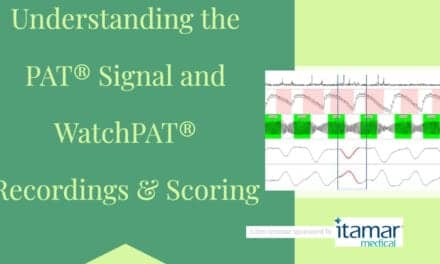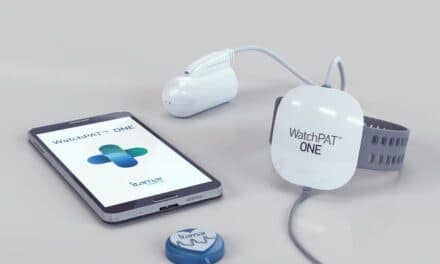A move toward even greater simplicity and ease of use could have widespread implications for sleep medicine.
In just under a decade, home sleep testing (HST) has gone from a controversial, hotly contested issue to one of the cornerstones of sleep medicine. But as with any technology, there are visionaries who are looking ahead to the next chapter.
And the future of HST may be a compelling mix of over-the-counter and advanced medical technology, which are as simple to use as they are effective. While these technological sleep pioneers may not agree on the single technology that should be used, they probably would agree on one point—contact between patient and device will be at a minimum.

Consumer and Medical Technology Collide
Sleep health consultant Paul Valentine, senior managing director at KCP Advisory in Boston, foresees a confluence of consumer and medical technology. For him, it’s already here in the form of the various smart watches that have been introduced.
They may be a good fit for the sleep medicine market, but he expects some growing pains. “Right now, we’re getting all this data from these activity trackers, but no one really knows what to do with it. No one is taking the data and putting it in a more readable form for the doctors. It’s still at an early stage,” he says.
While the technology is still in the “gadget” phase of its evolution, Valentine says a technological paradigm shift is already occurring. “There’s a shift from consumer sleep trackers on one side, and home sleep testing on the other….We have to figure out how these activity trackers can support a consumer becoming a patient,” he says. “I think we’re in this hybrid middle space and the question is: How do we connect the two?”
The trackers are used by consumers to track sleep and make adjustments to sleep practices based on its recommendations now, but the next logical step, according to Valentine, is taking that data to a clinician for expert help when the consumer device’s helpfulness hits its limits. “I don’t see us there yet, but that’s where we’re going and I see that’s true for all wearable devices,” he says. “The challenge is how you move people along the continuum. And I don’t think that gap is that big.”
Mike Thomas, chairman, CEO, and founder of Appian Medical Limited, would probably agree. Thomas’ company has developed a smartphone app that is designed to diagnose sleep apnea through recordings of a patient’s snoring. The app, which is still pending FDA approval, is not yet available.
The genesis of the technology, which involved surveying other companies that were developing contactless and wearable technology, came from a simple question. “We were trying to figure out what did we think [was] ultimately the best way to deliver the next paradigm shift in diagnostics in adult sleep apnea,” he says. “We concluded that it had to be smartphone enabled.”
The technology that forms the backbone of the app was an algorithm that the company licensed from the University of Queensland, Australia. Appian has performed two small clinical trials and is in the process of performing more. The first tests have been 93% accurate and effective, according to Thomas.
Simplicity is at the heart of the technology. Once it’s downloaded and the patient registers, he can begin the test. “With the app, it is going to be as simple as pushing a start button to record and everything is done for you,” Thomas says.

Anda Baharav, MD, chief scientist and founder of SleepRate, presented a poster at SLEEP 2014 called “How Fitness Heart Rate Belts And Mobile Phones May Be Used To Screen For Sleep Disorders.” After launching a medical device in 2007 that was “ahead of its time,” according to Baharav, the team tried the consumer route. Baharav and her team started looking at what was available off the shelf. The answer was heart rate belts. “When we compared the results that were coming from medical-grade ECG, they were quite similar,” she says. “So we started to use heart rate belts and a mobile application to look into the sleep of patients.”
Medical HST’s Future
While it’s clear that consumer technology may have an important part to play in helping identify sleep problems, contactless medical-grade technology is also being developed in parallel.
ApneaDx Inc has developed a device similar in concept to those of Thomas and Baharav. The ApneaDx records breathing and snoring sounds to diagnose sleep apnea. Its creators—Geoff Fernie, PhD, CEO and chief technology officer; Douglas Bradley, MD, chief medical officer; and Hisham Alshaer, MD, chief scientist—are expecting to shortly receive approval from Health Canada.
The device fits over a patient’s head with a small microphone situated in front of the patient’s mouth and nose in a shaped bowl to help capture breathing sounds, and a sensor to measure a patient’s head. There are no electrodes or wires involved. A single button turns the device on and off. The ApneaDx captures the patient sound recording on an SD card, which the patient sends to his or her physician for evaluation.
“The ApneaDx replaces the polysomnogram,” Fernie says. “The results are as accurate as the polysomnogram. It’s way less costly, way more comfortable, and way more reliable.”
Contactless home testing equipment isn’t just the purview of its creators. Mark Norman, PhD, postgraduate course coordinator, Department of Medicine, Discipline of Sleep Medicine, at the University of Sydney, has researched the efficacy of the Sonomat, a device that’s placed on top of a mattress and used to measure an array of patient data. It has been particularly effective in diagnosing children with sleep disorders.
“The Sonomat does not interfere with the subject’s typical sleep pattern, because there are no sensor attachments,” Norman says. “This is particularly important in young children where application of various sensors during setup often causes distress in the beginning of the night, and then interferes with normal sleep. This simplicity of the Sonomat means that it is much less complicated to set up compared to traditional equipment and enables untrained individuals to set up and undertake a study in the comfort of their own bed.”
The system is particularly helpful in detecting issues often associated with other cardiorespiratory problems, such as asthma.
“The Sonomat’s high quality recordings of respiratory sounds, such as wheezing, crackles, and stridor, provide measures that enable assessment of other cardiorespiratory disorders such as heart failure, asthma, and lung diseases,” Norman says. “Typically, these pathological sounds are only measured during a brief physical examination by an attending physician during a daytime consultation. The Sonomat records these sound signals over many hours of sleep, thereby enabling a physician to examine patients remotely in both time and place.” Sonomat also provides accurate recordings of snoring, Norman says, recording in a way that provides a quantitative measure of snoring that includes the frequency characteristics.
The Sonomat also measures body movement, which provides a good indication of sleep continuity and sleep disturbance.
Since the Sonomat can be used to record data over several consecutive nights or for weeks or months, it can be used to diagnose conditions whose symptoms vary over time.
Norman and his team have performed over 1,000 studies using the Sonomat and have found it works well for both adult and pediatric patients.
Whatever the method, it is becoming clear that contactless home testing technology may be the next phase in the growth of sleep medicine. The only question is when the next revolution will take place.
Top photo: The ApneaDx home sleep test eliminates the need for wires. The manufacturer is currently raising money for launch costs.
Thanks to doing research for this article, C.A. Wolski is looking forward to the day when there’s an iPhone app that will tell him the ideal moment he should go to bed to get a solid 8 hours.





